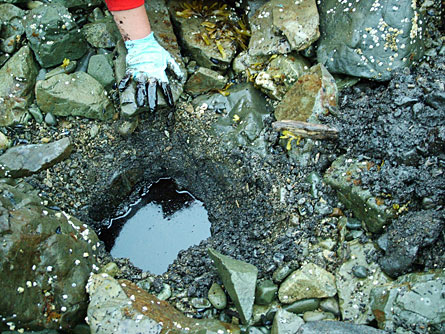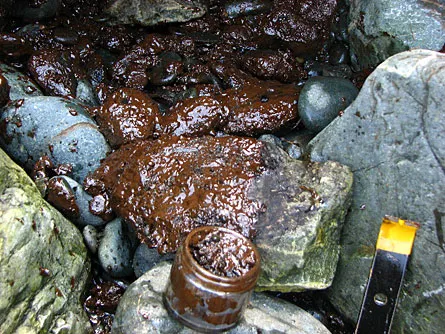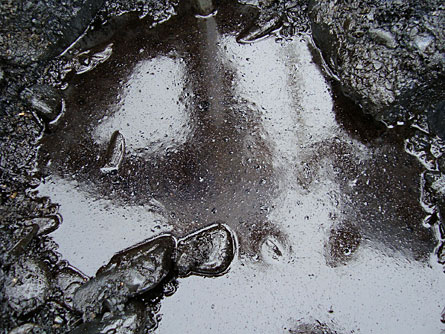Exxon Valdez oil lingers, as does its toxicity
Second in a series.
First part of the series: America’s worst oil disaster still isn’t over.



A few years after the 1989 Exxon Valdez accident — still the biggest tanker spill in U.S. history — once-oil-blackened beaches in Alaska’s Prince William Sound again looked clean and healthy. Some scientists now worry that those looks have been deceiving.
While surface oiling from the roughly 11-million-gallon spill of crude has disappeared, oil now turns up with some regularity just under the surface of tidal sediments in areas that initially had been heavily hit. Or so notes a 2009 Status Report that was issued this month by the Exxon Valdez Oil Spill Trustee Council. This joint state-and-federal body was established to oversee the use of a $900 million civil settlement (collected from Exxon Co. USA, now ExxonMobil) to restore the area’s oil-hammered ecosystems.
The Trustee Council has used settlement funds to finance substantial research investigating the spill’s full impacts and where continuing cleanup funds might be spent most effectively. And the Council now claims that one of “the most stunning revelations” to come out of the past decade of these studies has been a discovery of substantial amounts of lingering oil.
The natural removal of this residual oil has slowed to a glacial pace, it says — “0 to 4 percent per year, with only a 5 percent chance that the rate is as high as 4 percent.”
Especially troubling, it adds: In some places this oil “is nearly as toxic as it was the first few weeks after the spill.”
In 1994, based on the initial rates at which the spilled oil was disappearing, “there was a decision made to stop all remediation efforts on the beaches of Prince William Sound,” notes hydrologist Michel Boufadel of Temple University. Projections at that point suggested the oil would be nothing but a memory within a few more years.
By the late 1990s, data were painting a very different picture.
Researchers with the National Oceanic and Atmospheric Administration’s Auke Bay Laboratories in Juneau were frequently uncovering pockets of moderate to heavily oiled sediment of beaches in the intertidal zone of Prince William Sound. In 2001, they launched a survey to evaluate the extent of the problem.
They dug more than 9,000 shallow holes at 91 sites during a three month period. Oil turned up in more than half of the pits. To be fair, the holes were only dug at sites that had suffered heavily from the spill. Based on this sampling, NOAA scientists pegged the leftover oil at some 16,000 gallons. Continuing sampling would, two years later, up the estimate to 21,000 gallons.
Okay, it’s not scads of oil — at least when you consider what was dumped in the region initially. But it could be around a half of a percent of what was originally dumped onto affected beaches, says environmental chemist Jeff Short, Pacific science director of Oceana, an ocean-conservation group.
That’s his new gig. Until December, Short worked for NOAA in Juneau, where he spent most of his career studying Exxon Valdez oil and its impacts — from the first days after the spill.
And this oil “has not biodegraded nearly as much as we thought it would,” Short says. What’s more, data by his group at NOAA (and others) have shown that the oil in these long-lasting deposits still possesses what Short describes as “a substantial complement of its original toxicity.”
So how much of the fresh oil’s toxicity remains in these two-decade-old residues? “About half,” he told me. Much of that residual toxicity traces to what he calls nasty three-ring polycyclic hydrocarbons, such as phenanthrene.
In the initial weeks and months after the accident, weathering caused surface deposits of the spilled oil to quickly lose most of its volatile constituents. The resulting residues were tarry, asphalt-like material.
The oil that’s now being unearthed from below the surface of tidal sediment “is still pretty liquid,” Short says. “If it gets on your hands or gloves, it feels like oil and smells like oil.”
This is something residents in communities throughout the spill zone have commented on anecdotically for years. “In fact,” Short says, “there’s one possibly apocryphal story about a family that went on an outing and managed to ignite the beach.”
Area sea otters haven’t fully rebounded since the spill, and these intertidal-zone subsurface deposits of oil remain a major suspect. These animals dive under the water at high tide and excavate small pits to unearth clams, a dietary staple. “The oil can get right on their paws as they’re digging a hole,” Short says. And they’ll try to lick it off — by preening — because this stuff certainly doesn’t wash off. “I can attest to that,” he says.
“We did a study to estimate the likelihood that these otters would encounter oil if they just dug pits at random in the high-impact area,” Short says. “And we found it was enough that they would be exposed to oil several times a year.”
Two years ago, the Trustee Council hired Boufadel to investigate why this oil seems so recalcitrant to breakdown — and its presence so patchy. So for the past two summers his team has begun correlating the presence of residual oil with the movement of water across six intertidal beaches that had taken a big hit from Exxon Valdez crude.
Oil regularly shows up on five of the beaches just below the surface in the intertidal zone, he found. “Based on very rigorous measurements and modeling,” he says, “we find that you don’t have oil where you see fresh water moving from upland areas through the sediments to the sea.”
“So is this fresh water washing the oil away?” I asked. Possibly, he conceded, but then added: “We don’t think the freshwater is actually pushing the oil to sea. We think it’s possible that because of that water the oil never got trapped in some places.” His current hypothesis is that stagnant zones have developed within a beach and that any freshwater runoff detours around them.
So if oil gets into these stagnant zones, Boufadel says, a lack of water passing through them means there is little chance that biodegrading organisms will be funneled into the oil.
Indeed, he says, “the sad news is that on particular beaches there is a good chance that the oil disappearance rate is now zero percent. In these places, oil will not disappear” — at least not without help.
On the beaches his crew has been studying, they might encounter oil a few inches below the sediment in one area and nothing six feet away. “We should know very clearly within a couple of months why that is,” he says. And it’s potentially quite useful information. Knowing why oil will preferentially sit undisturbed in certain spots could help future cleanup crews pinpoint likely hideouts, he says — and where to target increasingly budget-strapped cleanup funds.
Next: Otters and oil: Problems remain






